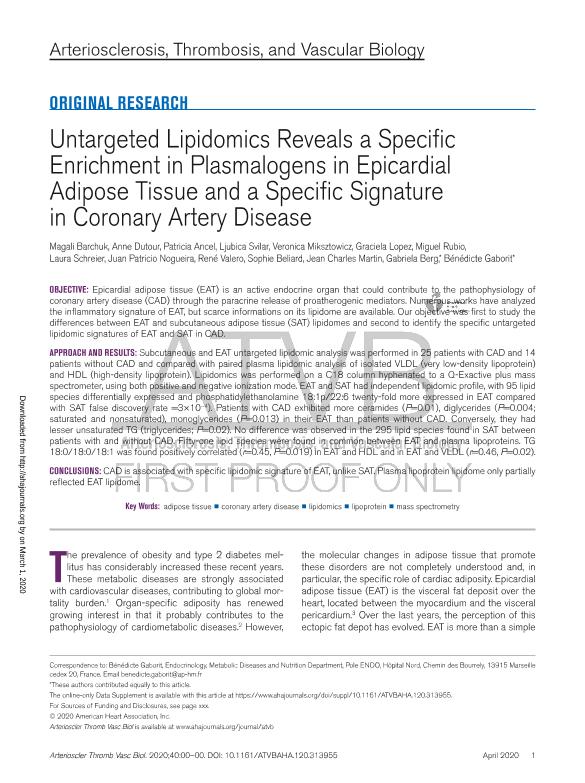Artículo
Untargeted Lipidomics Reveals a Specific Enrichment in Plasmalogens in Epicardial Adipose Tissue and a Specific Signature in Coronary Artery Disease
Barchuk, Magalí ; Dutour, Anne; Ancel, Patricia; Svilar, Ljubica; Miksztowicz, Verónica Julieta
; Dutour, Anne; Ancel, Patricia; Svilar, Ljubica; Miksztowicz, Verónica Julieta ; Lopez, Graciela; Rubio Mas, Miguel Angel
; Lopez, Graciela; Rubio Mas, Miguel Angel ; Schreier, Laura Ester; Nogueira, Juan Patricio
; Schreier, Laura Ester; Nogueira, Juan Patricio ; Valéro, René; Béliard, Sophie; Martin, Jean Charles; Berg, Gabriela Alicia
; Valéro, René; Béliard, Sophie; Martin, Jean Charles; Berg, Gabriela Alicia ; Gaborit, Bénédicte
; Gaborit, Bénédicte
 ; Dutour, Anne; Ancel, Patricia; Svilar, Ljubica; Miksztowicz, Verónica Julieta
; Dutour, Anne; Ancel, Patricia; Svilar, Ljubica; Miksztowicz, Verónica Julieta ; Lopez, Graciela; Rubio Mas, Miguel Angel
; Lopez, Graciela; Rubio Mas, Miguel Angel ; Schreier, Laura Ester; Nogueira, Juan Patricio
; Schreier, Laura Ester; Nogueira, Juan Patricio ; Valéro, René; Béliard, Sophie; Martin, Jean Charles; Berg, Gabriela Alicia
; Valéro, René; Béliard, Sophie; Martin, Jean Charles; Berg, Gabriela Alicia ; Gaborit, Bénédicte
; Gaborit, Bénédicte
Fecha de publicación:
04/04/2020
Editorial:
Lippincott Williams
Revista:
Arteriosclerosis, Thrombosis, and Vascular Biology
ISSN:
1079-5642
Idioma:
Inglés
Tipo de recurso:
Artículo publicado
Clasificación temática:
Resumen
OBJECTIVE:Epicardial adipose tissue (EAT) is an active endocrine organ that could contribute to the pathophysiology of coronary artery disease (CAD) through the paracrine release of proatherogenic mediators. Numerous works have analyzed the inflammatory signature of EAT, but scarce informations on its lipidome are available. Our objective was first to study the differences between EAT and subcutaneous adipose tissue (SAT) lipidomes and second to identify the specific untargeted lipidomic signatures of EAT and SAT in CAD. Approach and Results: Subcutaneous and EAT untargeted lipidomic analysis was performed in 25 patients with CAD and 14 patients without CAD and compared with paired plasma lipidomic analysis of isolated VLDL (very low-density lipoprotein) and HDL (high-density lipoprotein). Lipidomics was performed on a C18 column hyphenated to a Q-Exactive plus mass spectrometer, using both positive and negative ionization mode. EAT and SAT had independent lipidomic profile, with 95 lipid species differentially expressed and phosphatidylethanolamine 18:1p/22:6 twenty-fold more expressed in EAT compared with SAT false discovery rate =3×10-4). Patients with CAD exhibited more ceramides (P=0.01), diglycerides (P=0.004; saturated and nonsaturated), monoglycerides (P=0.013) in their EAT than patients without CAD. Conversely, they had lesser unsaturated TG (triglycerides; P=0.02). No difference was observed in the 295 lipid species found in SAT between patients with and without CAD. Fifty-one lipid species were found in common between EAT and plasma lipoproteins. TG 18:0/18:0/18:1 was found positively correlated (r=0.45, P=0.019) in EAT and HDL and in EAT and VLDL (r=0.46, P=0.02).CONCLUSIONS:CAD is associated with specific lipidomic signature of EAT, unlike SAT. Plasma lipoprotein lipidome only partially reflected EAT lipidome.
Archivos asociados
Licencia
Identificadores
Colecciones
Articulos(OCA HOUSSAY)
Articulos de OFICINA DE COORDINACION ADMINISTRATIVA HOUSSAY
Articulos de OFICINA DE COORDINACION ADMINISTRATIVA HOUSSAY
Citación
Barchuk, Magalí; Dutour, Anne; Ancel, Patricia; Svilar, Ljubica; Miksztowicz, Verónica Julieta; et al.; Untargeted Lipidomics Reveals a Specific Enrichment in Plasmalogens in Epicardial Adipose Tissue and a Specific Signature in Coronary Artery Disease; Lippincott Williams; Arteriosclerosis, Thrombosis, and Vascular Biology; 40; 4; 4-4-2020; 986-1000
Compartir
Altmétricas



